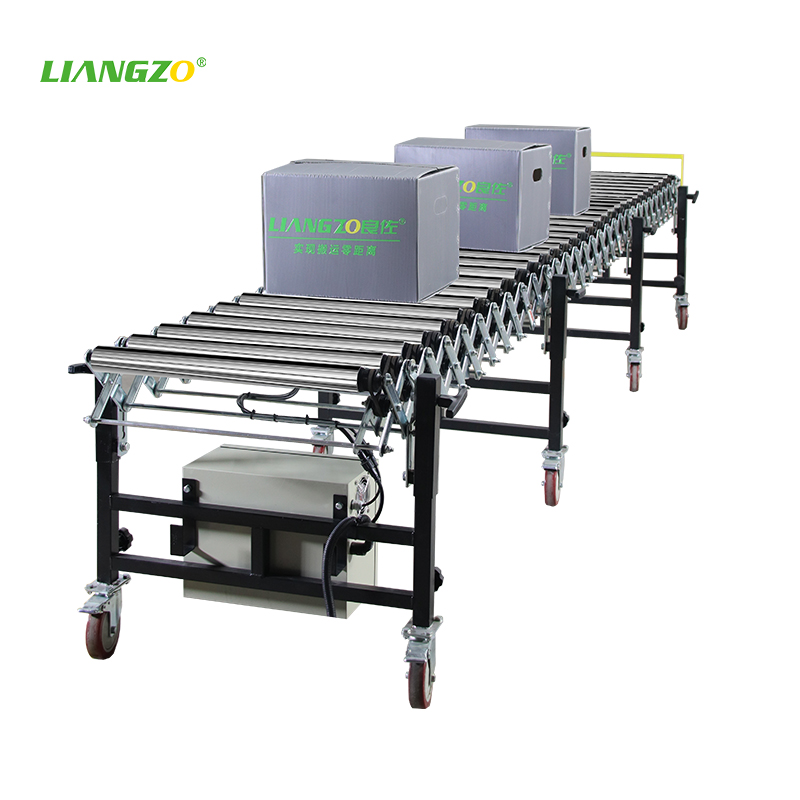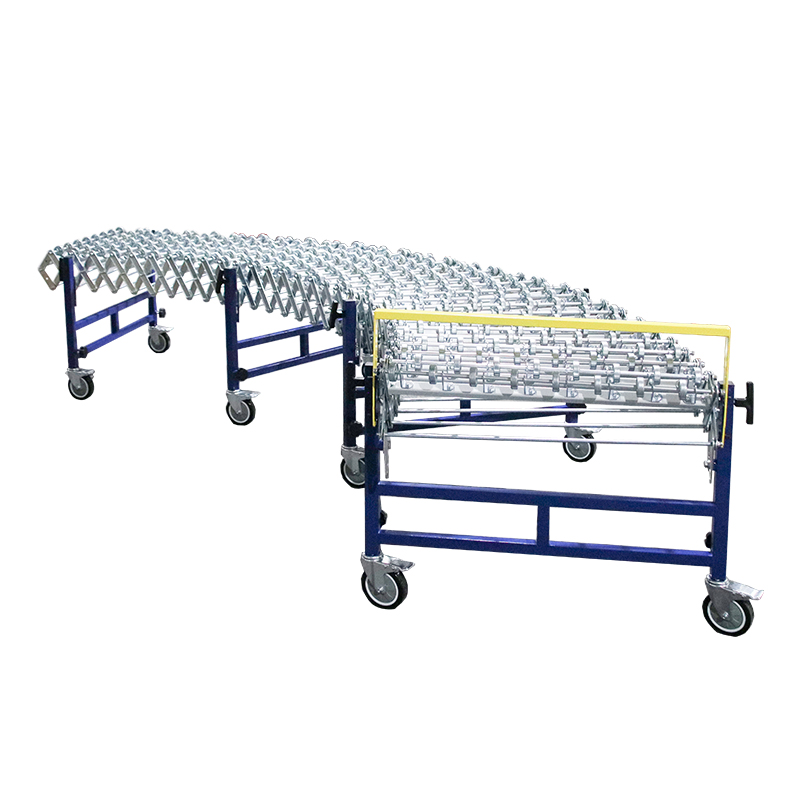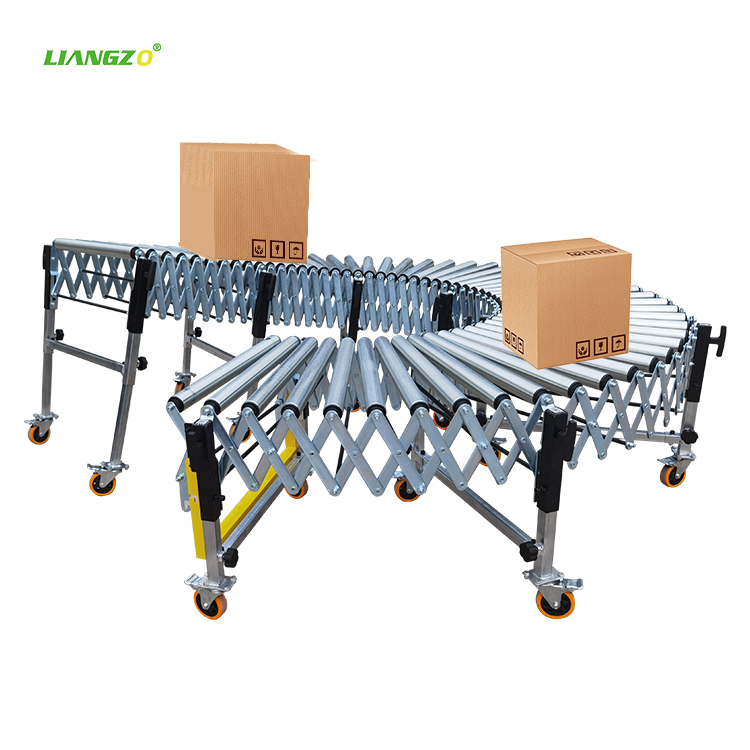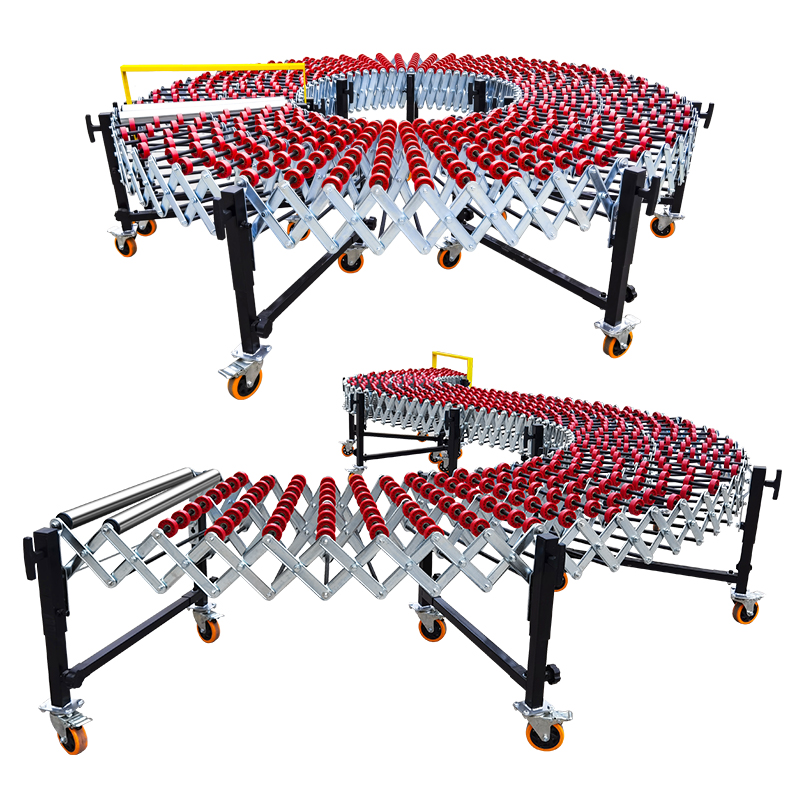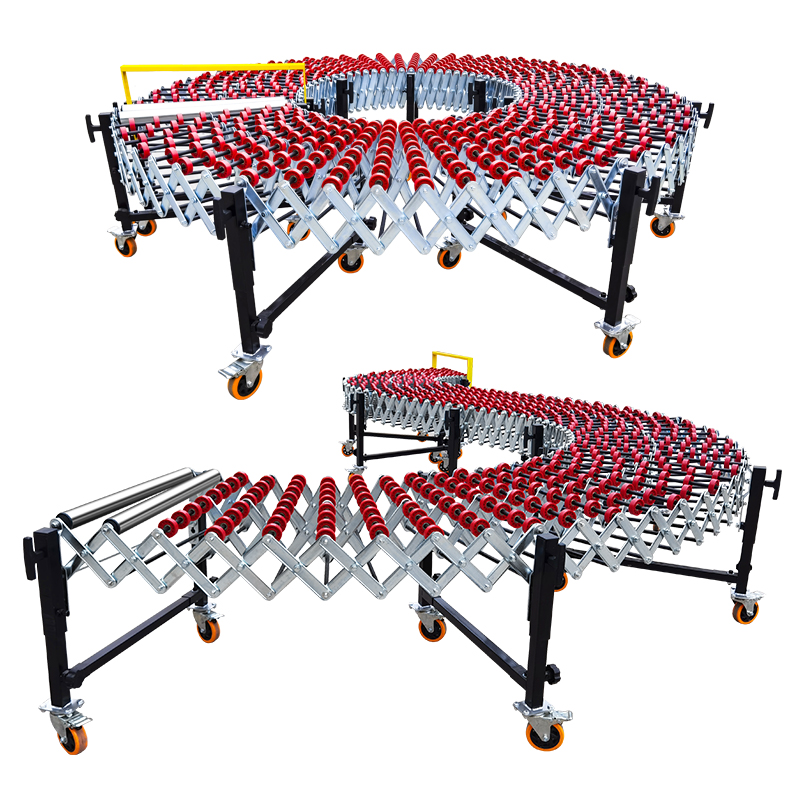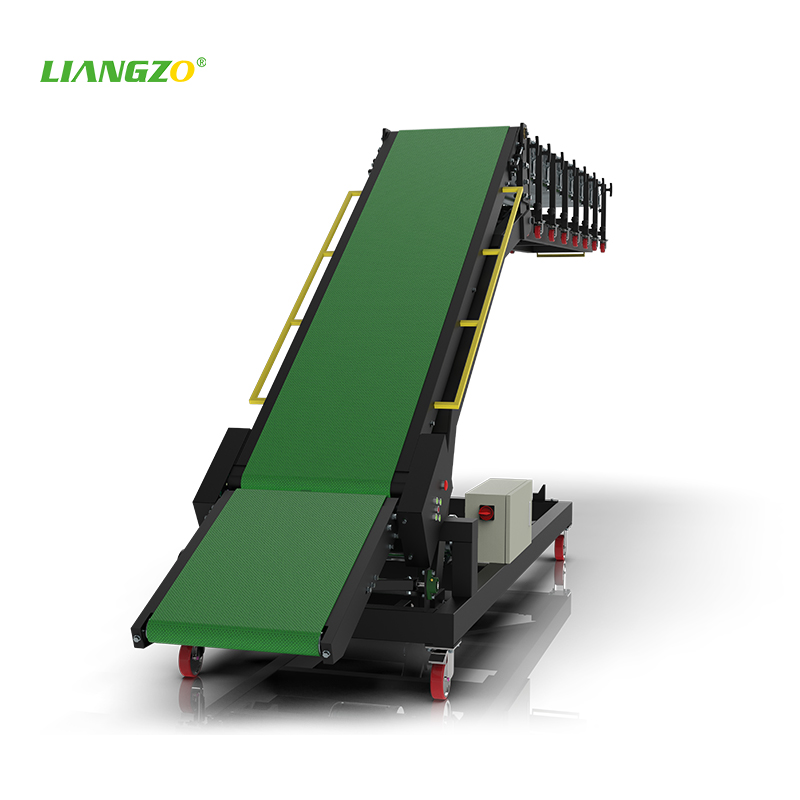Understanding the Fundamentals: What is a Telescopic Belt Conveyor?
Before examining its applications, it is crucial to understand what sets a telescopic conveyor apart. In essence, it is a modular, extendable conveyor system comprising a main base and multiple boom sections that can slide in and out of each other, much like a telescope. Powered by an electric motor, the entire belt—which sits atop this telescoping structure—extends and retracts, allowing the discharge point to be positioned precisely where needed. Key features include:
Extensibility and Retractability: The core function, enabling the conveyor to reach deep into a truck or shipping container without the need for manual labor to carry goods to and from the fixed end.
Variable Length: Models can range from extending 10 meters to over 30 meters, catering to different vehicle sizes.
Mobility: Most are mounted on wheeled bases, allowing a single unit to service multiple loading bays.
Safety and Control: Equipped with emergency stop buttons, variable speed controls, and often, remote-control operation for precision and operator safety.
Customization: Available with side guards, roller beds, cantilevered designs, and capabilities to handle a wide range of weights and product types.
It is this unique combination of reach, mobility, and control that unlocks a vast array of applications.
Primary Application Domains
The applications of telescopic belt conveyors can be broadly categorized into several key domains, each addressing specific operational needs.
1. Loading and Unloading of Trucks and Shipping Containers
This is the quintessential and most widespread application. The process of loading or unloading a 40-foot trailer or a standard shipping container is physically demanding, time-consuming, and fraught with risks of product damage and worker injury.
Application in Action: A telescopic conveyor is wheeled into position at the dock door. The operator extends the boom, guiding the discharge end directly to the far end of the truck or container. For unloading, workers at the far end simply place parcels or boxes onto the moving belt, which carries them smoothly back to the dock, where they can be sorted or fed onto a main warehouse conveyor system. The process is reversed for loading. The operator can gradually retract the conveyor as the work progresses, minimizing walking distance for employees and drastically reducing loading/unloading times—often by more than 50%.
Industry-Specific Impact:
Parcel & Postal Hubs: For giants like FedEx, UPS, and DHL, speed is paramount. Telescopic conveyors allow for the rapid turnarounds of delivery vans and large trailers, ensuring next-day delivery promises are kept.
E-commerce Fulfillment Centers: Handling millions of diverse SKUs, these centers rely on telescopic conveyors to manage the massive influx and outflux of goods, especially during peak seasons like Black Friday or the holidays.
Food and Beverage Distribution: Efficient handling of palletized and non-palletized goods, such as cases of drinks or canned foods, is critical. The gentle handling reduces the risk of damaging packaging and the products within.
Retail Distribution: Large retail chains use them to efficiently load store-bound trailers with a mixed assortment of merchandise.
2. Cross-Docking Operations
Cross-docking is a logistics strategy where incoming goods from suppliers are immediately sorted and redirected to outbound transportation with minimal or no storage time in between. This requires a seamless, rapid flow of materials.
Application in Action: In a cross-dock facility, inbound trailers are unloaded directly onto telescopic conveyors. These conveyors feed the goods onto a central sortation system. Once sorted, the outbound goods are conveyed to another bay, where a second set of telescopic conveyors loads them directly into waiting outbound trailers. The telescopic nature of the conveyors ensures that the transfer is direct, eliminating unnecessary handling and minimizing the dwell time of goods in the facility, thus optimizing the entire supply chain.
3. Air Cargo Handling
The air freight industry operates on an even tighter schedule than ground logistics. The rapid transfer of cargo between warehouses and aircraft holds (via Unit Load Devices or loose cargo) is critical for maintaining flight schedules.
Application in Action: Telescopic conveyors are used to load and unload the narrow-bodied and wide-bodied aircraft containers. Their ability to extend to the precise required depth ensures that baggage and cargo can be moved swiftly and efficiently. In airport warehouses, they facilitate the sorting and transfer of air freight between trucks and aircraft cargo holds, ensuring that time-sensitive shipments, such as perishables or medical supplies, are processed without delay.
4. Manufacturing and Production Lines
While often associated with logistics, telescopic conveyors also find valuable applications within manufacturing environments, particularly in scenarios requiring flexible feed points.
Application in Action:
Raw Material Intake: They can be used to unload raw materials delivered in containers or trucks directly onto the production line feed conveyors.
Flexible Assembly: In large assembly plants, such as for automobiles or appliances, a telescopic conveyor can be used to deliver components to different stations along a line without the need for a fixed, space-consuming conveyor network.
Finished Goods Dispatch: Once products are manufactured and packaged, they are often palletized and shipped. Telescopic conveyors streamline the process of loading these finished goods onto outbound transportation.
5. Baggage Handling in Transportation Hubs
Beyond air cargo, telescopic conveyors are integral to passenger baggage handling systems at airports, train stations, and cruise terminals.
Application in Action: At airports, they are used at check-in counters to transport baggage from the check-in desk into the main baggage handling system. More significantly, they are used to load and unload baggage from the carts or containers that transport it to and from the aircraft. This ensures a smooth, automated flow of luggage, reducing the likelihood of mishandled bags and improving passenger experience.
6. Specialized and Niche Applications
The versatility of telescopic conveyors allows them to be adapted for more specialized tasks.
Refuse and Recycling: In large waste management facilities, telescopic conveyors are used to load and unload compacted waste from transfer trailers into processing areas or incinerators.
Moving and Storage: For the moving industry, they facilitate the efficient loading and unloading of household goods from moving trucks, reducing physical strain on workers and the risk of damaging valuable items.
Military and Disaster Relief: In scenarios requiring rapid deployment of supplies, telescopic conveyors can significantly speed up the process of unloading equipment, food, and medicine from military transport planes or shipping containers in makeshift logistics hubs.
The Tangible Benefits: Why the Investment Pays Off
The widespread adoption of telescopic belt conveyors is driven by a compelling return on investment derived from several key benefits:
Dramatic Increase in Efficiency and Productivity: By automating the most labor-intensive part of loading/unloading, a single conveyor can do the work of several manual laborers. Cycle times for trucks are slashed, meaning more vehicles can be processed per day, reducing dock congestion and maximizing asset utilization.
Significant Labor Cost Savings and Ergonomic Improvement: These systems reduce the required manual workforce for loading/unloading tasks. More importantly, they drastically lower the risk of work-related musculoskeletal disorders (WSMDs) caused by repetitive lifting, carrying, and twisting. This leads to a healthier workforce, lower absenteeism, and reduced insurance premiums.
Enhanced Safety: Beyond ergonomics, they improve overall site safety. Operators can work from a safe position, reducing the risk of collisions with forklifts or falls from trailers. Emergency stop functions and controlled movement prevent accidents.
Reduced Product Damage: The consistent, gentle movement of a belt conveyor is far less likely to cause impact damage compared to manual throwing or mishandling. This is crucial for fragile items, electronics, and high-value goods.
Unparalleled Flexibility and Space Optimization: A single mobile telescopic conveyor can service an entire bank of loading docks, eliminating the need for a fixed conveyor at every door. This saves valuable floor space and offers a cost-effective solution for facilities with fluctuating demand across different docks.
Improved Load Quality and Stability: By allowing the operator to place items precisely where needed inside the trailer, these conveyors enable better stacking and weight distribution, leading to safer and more stable loads for transportation.
Selecting The Right Telescopic System
1. Vehicle Mix – Measure the longest trailer; the boom must extend 1 meter beyond the midpoint.
2. Product Type – Choose belt width for carton or sack base.
3. Dock Height – Confirm elevation adjusts for air‑ride drop.
4. Traffic Pattern – If doors double as staging, select full retraction plus powered traverse.
5. Supplier Credibility – Compare truck loading conveyor manufacturers based on installations, service reach, and spare parts lead time.
Also read: How To Choose a Conveyor ?
Maintenance And Safety Essentials
● Daily: Clear debris and check emergency-stop lanyards.
● Weekly: Inspect belt tension; grease extension rails.
● Monthly: Verify sensors on the flexible powered roller conveyor chain.
● Quarterly: Calibrate VFD settings; slow acceleration protects motors.
● Annually: Invite OEM technicians for structural checks and firmware upgrades.


